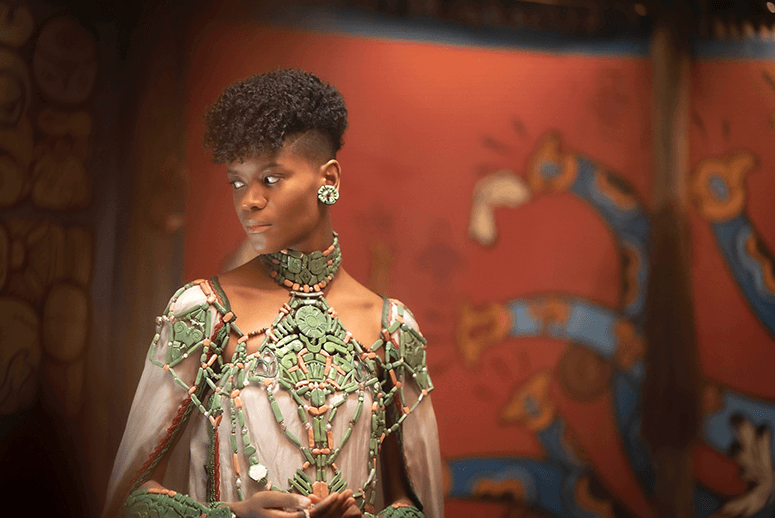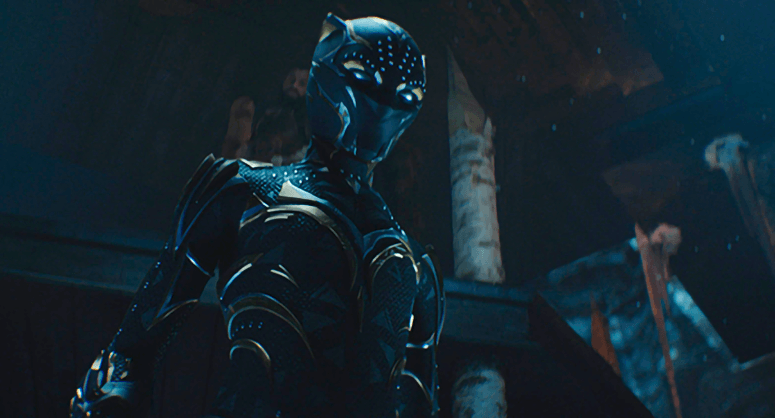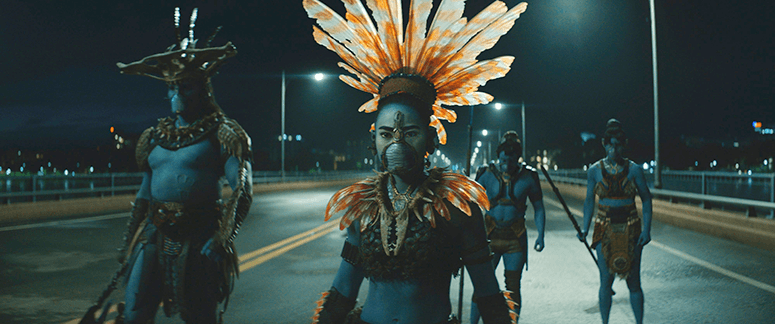Wakanda Vision
Chadwick Boseman, aka Black Panther, is barely shown in the sequel to the 2018 Marvel Studios blockbuster, but his presence lingers in Black Panther: Wakanda Forever like a burnt offering. We see him in a pre-credits Marvel montage, and in fond, flickering flashbacks. Replacing the main character in a billion-dollar franchise was never going to be easy. Stepping up her game, little sis Shuri (Letitia Wright) takes center stage, reluctantly adopting the role of protector of the troubled but dazzling Wakanda.
After a mourning sequence at the opening, we shift from a Wakanda of the imagination to the real world, where the United Nations is squabbling over vibranium, the metal that has hyper-powered Wakanda’s technology and is sourced only from its Mount Bashenga. The other world powers want it, and grumble about the hidden kingdom’s hoarding it all this time.

Enter Queen Mother Ramonda (Angela Bassett), who sashays/barges into the UN General Assembly with her entourage, ready to throw down. Bassett does have some fierce screentime in this sequel, and though she’s occasionally broad, it’s a role that gets your attention. She points out that if Wakanda wanted to destroy the rest of y’all, "we coulda done it long ago."
Wakanda exists in the imagination largely because of its cloaked isolation. For centuries, vibranium has kept out the rest of the world. But the CIA has developed vibranium-detecting technology, and when their underwater mining team are attacked and killed, Wakanda is blamed.

Turns out there’s another race of oppressed people of color who have long embraced vibranium and its world-changing potential. They’re led by Namor (Tenoch Huerta Mejia), an ancient Aztec scion who is transformed by an underwater plant into a pointy-eared, feather-footed, water-breathing serpent god whom his blue-skinned underwater people refer to as Ku’uk’ulkan. He’s angry about the CIA breach and is ready to declare war on the outside world.
He demands that Ramonda help him track down who developed the vibranium-hunting machine for the CIA and then join in his quest to destroy all the humans, but Ramonda is like, uh, no thanks, we’re cool, which just makes him go berserk.

Shuri, meanwhile, wants to leave behind the old ways of the Black Panther. She and big brother didn’t always get along, so she decides to keep the old suit and mask locked up in a kind of high-tech shrine as she works on new, better vibranium-based apparel. Also, she believes the old heart-shaped herb could have saved T’Challa, and is focusing on synthesizing her own.
Wakanda, as ever, is a collective of sometimes bickering tribes that will, at the drop of a hat, dance and celebrate together. Kind of like family. They also kind of need a leader, but as mentioned, T’Challa is no longer around. Ramonda rules with her steely gaze most of the time as a de facto queen.

Tipped by CIA good guy Everett Ross (Martin Freeman), Shuri heads to Boston and the MIT campus, where she finds genius student Riri (Dominique Thorne) who has invented all kinds of advanced technology that the CIA and world governments don’t even know about. They’re both kidnapped by Namor and his blue underwater people and taken to Talokan, which seems as advanced and Latin-futuristic as Wakanda, though much more wet.
Once again, Coogler brings a fantastical world to life in all its detail and fleeting beauty. But it’s guided by the vengeful Namor who, basically, is angry at white (Spanish) people for colonizing and oppressing his Aztec ancestors.

So there’s a kind of underlying, seething subtext here about the effects of racism that is palpable, yet never fully explored. (It’s a Marvel movie, after all.) So instead of correcting the errors of history, what we mostly get, once again, is various people of color beating each other up. It was kind of problematic in Black Panther, the sight of so much black-on-black violence (and if we are to say that tribal violence is part of a certain historical “culture,” then we are forced to reply that some aspects of “culture”—such as slavery—should be left behind, not celebrated). Here, it’s blue people beating up black people, black people beating up brown people, again and again. I just wish there was a focus on the heart of the problem here, which I guess is greed, whatever shade it is.
On the other hand, Coogler directs his action and fight scenes with an up-close, kinetic intensity that is very different from other Marvel movies. (The jittery, handheld style—such as the desert fight between Shuri and Namor—sometimes reminds me of Mexican wrestling movies like Santo and Blue Demon vs. The Monsters.)

The vision of Wakanda itself (Wakanda vision, if you will) is equally stunning and world-building. Intermingling futuristic elements with surrounding nature, it’s a place you can surrender your imagination to.
Also to its credit, Black Panther already laid down a world of enough dimension and detail to sustain repeated visits. It’s stocked with memorable characters, each with their own flaws, except, oddly, T’Challa, who is seen here by Shuri (and Kilmonger) as too “noble.”
There is some lip service paid to “science” here in the guise of Shuri who, working with the fully-onboard Riri (who marvels at Wakandan technology and will eventually become Ironheart), wants to reverse-engineer a way to stand up to the superior Namor army. She dabbles around with some 3D molecule models, and we think we’ll see some actual hardcore science (conducted by women!) onscreen, but—surprise—it’s all just a montage to get us to another fight scene.
And here, again, are quite a lot of powerful women: you’ve got Lupita Nyong’o as Nakia, Danai Gurira as Okoye, Florence Kusamba as Ayo, and Michaela Coel as Aneka—all as dedicated to defending Wakanda as any male warrior.
Shuri has the most growing up to do. She has to think about filling T’Challa’s shoes, but also deciding which world, or worlds, really matter. It’s a lot for someone who’s barely left Wakanda. When the transformation comes, and Shuri revisits the heart-shaped herb to take her own vision quest journey to her ancestors, it’s to find out who she really is, and what kind of spirit is guiding her. Though a bit too long, Wakanda Forever is worth the journey.



